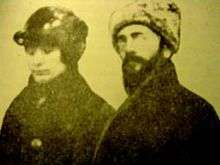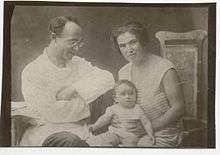Aron Baron
| Aron Baron | |
|---|---|
 Aron Baron, 1911 | |
| Born |
Aron Davidovich Baron July 1, 1891 Gnilets, Kiev Governorate, Russian Empire |
| Died |
August 12, 1937 (aged 46) Tobolsk, Russia |
| Cause of death | Executed |
| Other names |
Aron Polevoy Aron Faktorovich Aron Kantorovich |
| Occupation |
|
| Spouse(s) | Fanya Baron, Fanny Avrutskaya |
| Children | Theodore, Voltairine |
Aron Baron (Russian: Аро́н Дави́дович Ба́рон; 1 July 1891 – 12 August 1937) was an anarcho-syndicalist revolutionary and theorist, brother of the Red Cossacks Army Ataman Mikhail Baron. Pseudonyms included Faktorovich, Kantorovich, Polevoy.
Early life
Baron was born into a petty bourgeois family of eight in Gnilets, Kiev Governorate on 1 July 1891 to David (who was born Faktorovich and changed his surname to avoid military service), a jurist, and Mindel (née Rabinovich), a housewife. While still a school student, working as a baker, he joined the anarchist movement and took part in the 1905 Revolution.[1] In 1907, as a member of the baker's union of Kiev, he was arrested and exiled.
From Russia to America
In 1912, Baron fled to the USA, settled in Chicago and joined the Industrial Workers of the World. While staying with the family of his brother Newman, he met his wife's sister, Fanya Grefenson, who became Baron's companion and fellow activist. Baron started working as a co-editor of Lucy Parsons' weekly anarchist newspaper, The Alarm and cooperated with the Union of Russian Workers. While living in Chicago, Baron regularly took part in demonstrations organised by American workers, also becoming involved with Russian and Jewish trade unions and anarchist groups. In January 1915, Baron and his wife led a march against unemployment, clashing with police and being severely beaten.[1] His political activism led to prison terms several occasions.
Back to Russia
In June 1917, Aron and Fanya Baron came back to Kiev. There, Baron became the head of a local anarcho-syndicalist group and was elected to Kiev's Soviet of Worker's Deputies. He found popularity among workers, soldiers and peasants as a lecturer. In the autumn, he raised an anarchist unit to fight the Cossack troops of Alexey Kaledin, and later the Germano-Austrian troops.
In July 1918, Baron was in Kursk, where he started a local anarchist newspaper and worked on the creation of the Nabat, an organisation that aims to unite all anarchists of Ukraine. The inaugural Congress of the Nabat Confederation of Anarchist Organisations took place from 12–16 November: Baron was elected to the Secretariat, and became, along with Volin, a co-editor of the Nabat newspaper.[2] For two years, he remained the Confederation's main leader and ideologist.

In January 1919, Baron was in Kharkiv as a result of a military offensive, and a month later he was in Ekaterinoslav, setting up local Nabat groups wherever he went. From 8–10 February, Baron was arrested for his lecture titled "Anarchism and Soviet Power". Once freed, he participated in the second Huliaipole District Congress (12–18 February), criticising Bolsheviks for corruption and persecution of both workers and members of revolutionary organisations. His next destination was Kiev, where, in early April, he was arrested again. During the first Nabat Congress (2–7 April) in Yelisavetgrad, he was re-elected in absentia to the Secretariat. From April to June, Baron was in Odessa editing the Odessa Nabat newspaper. However, on 16 June, after seven publications, the paper was banned and in the summer of the same year, Baron left for Moscow, where he edited the Moscow "Nabat" newspaper. On 9 October he was arrested there for alleged ties to Underground Anarchists, who were behind a terrorist attack on the Russian Communist Party headquarters in Moscow. He had previously condemned the attack and denied any affiliation with its perpetrators.[3] While in prison, he created and joined an investigative commission to defend the rights of imprisoned legal anarchists. The goal of the commission was to investigate the circumstances of the terrorist attack, which the detainees were accused of. In November, Baron proved their innocence and was set free, but suffered from typhus and other health issues.
In early 1920 he went back to Kharkiv, taking part in clandestine Nabat conferences (February and April). He was elected representative of the Nabat Secretariat at the Soviet of Revolutionary Insurgents. Baron was arrested for ties to Makhnovists, but released after a nine-day hunger strike. In mid-June, along with other Nabat leaders, he joined the Revolutionary Insurrectionary Army of Ukraine. That summer, he became actively involved in the Makhnovist army and worked in the editing department of the Povstanets newspaper. He viewed the Soviet government as an enemy, and discouraged cooperation with the authorities. He insisted on the need for Makhnovists to use armed force in order to occupy sizeable territory where they could establish an anarcho-communist society (either in Ekaterinoslav or Crimea). Baron's efforts to reaffirm the authority of the Nabat in Makhnovist ranks and interfere with military affairs led to a conflict between himself and Makhno, whom he derogatively referred to as a "Ukrainian Napoleon". Baron ultimately resigned from the RIAU.
In September 1920 he was arrested in Moscow by the Cheka.
Decline and death

From 1920 Baron was either jailed or exiled on a near-permanent basis. In early October 1920, he was released under the terms of the politico-military agreement between the RIAU and the Soviet authorities and returned to Kharkiv. There, he agreed to a cooperation between the Nabat and the RIAU and took active involvement in organisational and propagandist work. He spoke at meetings set up at factories and mills on a daily basis, at the same time co-editing the Nabat and Golos Makhnovtsa newspapers, organising anarcho-syndicalist trade unions, and planning an all-Ukrainian anarchist Congress. On the night of 25–26 November, during a crackdown on Nabat members orchestrated by Leon Trotsky, Baron and his wife, among hundreds of others, were arrested by the Cheka.[1] In December, Baron, along with other anarchist leaders, was brought to Moscow by foot and kept at the Internal prison of the Cheka.
In January 1921, along with others, he was taken to the infamous Butyrka prison. On February 13, after Peter Kropotkin's death, seven anarchists, including Baron and his wife, were released for the day of the funeral.[4] This procession was to become the last public demonstration of anarchists until 1988. Several leaders, including Aron Baron and Emma Goldman, as Kropotkin's closest sympathisers, were given a special spotlight in front of a crowd of thousands as each of them gave speeches. In his speech, Baron criticized Kropotkin for his attitude towards World War One.[5] Starting from 26 April, Baron, severely beaten, was detained at the Oryol Prison, where he started an 11-day hunger strike in protest. On 10 July, Fanya Baron escaped from the Ryazan prison and found refuge at Semion Baron's, her brother-in-law's, apartment in Moscow. They started working on a plan to get her husband out of prison. However, on 17 August, they were found out after a nationwide search. Semion was shot on the spot, and Fanya was executed in September, under accusations of terrorism. In the autumn, Aron Baron was again moved to a prison in Moscow.
In January 1922, he was kept at the Yaroslavl prison, where he participated in a mass protest of socialists, after which he was roughly beaten and hospitalized. Once back on his feet, he was successively imprisoned in Vladimir and Nizhny Novgorod. In August, Baron is taken to Moscow to attend a supposed revtribunal. In October, he was brought back to the Kharkiv prison, and on 3 November, after an 8-day hunger strike, went through a short-term release. He traveled to Kiev, where his new partner, Fanny Avrutskaya, an anarchist friend and future mother of his daughter Voltairine, was very ill. He was given a chance to be sent out of the USSR to Berlin, on the condition that he abstain from any anarchist activity during the following month. However, he was accused of having broken the agreement by having left the city of Kharkiv. He was arrested on 18 December 1922 and on 5 January 1923 was sentenced to two years of exile for "clandestine propaganda". Baron was sent first to the Pertominsk concentration camp. Protesting against the conditions of his exile, in June 1923, he attempted self-immolation, but survived, although seriously burnt. He was then sent to the Kem labour camp and from there to the Solovki prison camp, where he contracted a serious eye infection. Baron was the elected starosta for anarchists on Savvatyevsky Island.

On 5 January 1925, Baron was released and returned to Moscow. During his previous term, many foreign anarchists, including John Turner, had offered their sympathies, but only succeeded in getting him charged with having "aroused public sentiment abroad against his imprisonment in the Solovki and having induced revolutionists visiting Russia to seek his release."[3] The same month, Baron was sentenced to three years of exile and sent by foot first to the Novosibirsk (then called Novonikolayevsk) prison, then to the Altai region in Siberia and the Yeniseysk area in the spring. In the latter location, in April 1926, he was found to have corresponded with foreign comrades and redirected to Karassino, an obscure location in the Turukhansk area, where mail was delivered only three times a year. In 1928, he was sentenced to three more years of exile to Tashkent. In 1931 he was authorized to return to the European part of the USSR, but prevented from living in any big city, so he settled in Voronezh, working as an economist for the local energy trust, leading a group of Underground Anarchists and keeping contact with other such groups in Oryol, Bryansk and Kharkiv. On 27 January 1934 Baron was arrested by the NKVD for activism against the kolkhoz/sovkhoz system. On 14 May 1934, he received yet another sentence.
For the following three years, he lived in exile in the Obsko-Irtyshskaya oblast. In 1937, he lived in Tobolsk, working as a planner of the local market. On 20 March 1937, he was arrested for the last time. On 5 August 1937, he was sentenced to death, and on 12 August, executed.
Baron was posthumously rehabilitated by the Soviet authorities on 8 February 1957. The fate of his second wife and daughter remains unknown.
Legacy
In January 2013, a group of political activists in Kiev unofficially renamed Moskovskaya Street to Aron Baron Street, changing signs on buildings accordingly. . Serhiy Zhadan included a poem about Baron in his 2012 poetry book.[6]
References
- 1 2 3 Avrich, Paul (2005). The Russian Anarchists. AK Press. p. 320.
- ↑ Volna, No. 28, April 1922, pp. 12-14; Goneniia na anarkhizm v Sovetskoi Rossii, pp. 36-37
- 1 2 Maximoff, G.P. (1940). The Guillotine At Work: Twenty Years of Terror in Russia. Chicago: The Chicago Section of the Alexander Berkman Fund. p. 632.
- ↑ Serge, Victor (1963). Memoirs of a Revolutionary, 1901-1941. London: Oxford UP. p. 220.
- ↑ "You will remember that when A. Baron had attacked P. K[ropotkin] during the funeral services in Moscow, I was much incensed against Baron. What Baron then said was, on the whole, justified, but I considered the time and place badly chosen. But... over a decade after P. K.'s death, we should have... a calm and objective dissection of the attitude of Kropotkin to the great war. Not only because it was Kropotkin, but mainly because his attitude had many admirers and has helped to split the anarchist movement…" Aug. 26, 1931 (excerpt from a letter by Berkman from the Amsterdam archive)
- ↑ Zhadan, Serhiy (2012). Вогнепальні й ножові. Family Leisure Club. p. 160.
External links
- Kate Sharpley Library profile
- Profile